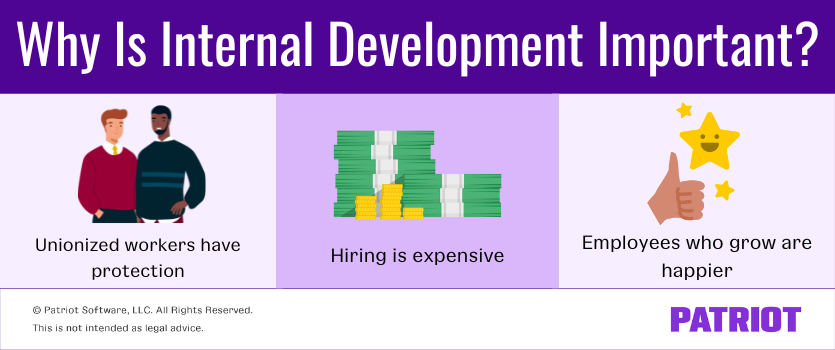When economic times are good, companies can grow and bring in some of the best and brightest names from outside the organization to help the entire unit thrive.
But in times of economic uncertainty or even recession, the recruitment process can become a costly and time-consuming venture.
When that happens, many businesses turn their eyes inward, switching focus from hiring to internal development. By building your internal development, you can continue to scale your company without spending time and money looking for external hires.
But, why is internal development so important during economic downturns? And how can you improve your internal development? In this article, we’re going to cover both of these questions in detail.
Why is internal development crucial during an economic downturn?
During times of economic uncertainty, switching focus to internal development can reduce unnecessary expenses associated with hiring new employees and improve employee engagement. Employees may be concerned about pay cuts or downsizing. Showing them that you are committed to their growth even through a downturn will surely improve morale. Mitigating the loss of top talent through internal development opportunities will protect team productivity and as a result, your bottom line.

1. Unionized workers have protection
In times of economic crisis, laying off your employees to focus on external hires can be seen as a bad PR move. On top of that, unionized workforces often have protections that limit their risk of job loss. This is still true during periods of economic crisis.
One of the top three reasons workers join a union is for job protection. And during an economic downturn, scaling back becomes more difficult for business owners. That’s why it’s better to limit hiring and focus on internally developing employees to meet the company’s growing needs.
2. Hiring is expensive
When the economy is in a period of recession, every dollar counts. Hiring outside your company is not cheap. According to studies, the average cost of hiring an external employee is $4,000 but could vary depending on the industry.
These costs are spread throughout the following processes:
- Recruitment
- Interviewing
- Onboarding
- Training
Conversely, developing your existing workforce and allowing them to advance within the company costs far less. The training period will also be less time-intensive, as your team members are already familiar with the company and its practices.
3. Employees who grow within a company are happier
The benefits of internal development will have a wide reach within your company. Not only are you reducing hiring expenses, but you’re also upskilling employees and increasing their overall engagement and satisfaction.
You’re promoting internally, moving people within a company they’re already familiar with and comfortable with. This creates happy employees who will develop a sense of belonging and loyalty within your organization.
Internal development can also curb the risk of insider threats by reducing employee negligence (due to better training) and disgruntled employees (due to increased engagement).
Want to impress your friends at a dinner party?
Get the latest small business news delivered straight to your inbox.
Subscribe to Email ListHow to shift focus to internal development
Interested in focusing on internal development? Take a look at the three tips below to get started.
1. Offer enhanced benefits to reduce churn
The first way that you can shift your focus to internal development during a period of economic unrest is by ensuring employees don’t quit on you. Employee turnover will inevitably lead to having to look outside the business for new members of your staff.
Figure out what it is that your workforce desires above all else. It’s not always money. Sometimes, specific benefits are seen as highly desirable, and you’ll be able to get more longevity from your existing employees by offering them.
A surprising 34% of workers said they would consider up to a 5% pay cut if they were able to work remotely. If you need to reduce costs during an economic downturn, consider offering this option. It not only makes your team happier, but you’re also able to offer employees more flexibility without breaking the bank.
2. Start an employee training program
Your employees need to know that you’re committed to improving their careers through internal advancement. To do this, consider making resources available to them, including a management training program. This can include coursework, hands-on experience, and job shadowing to help isolate interested parties and ensure they’re ready when the time comes.
Aside from high-quality training, you must ensure that your employees have the tools and assets needed to have a positive work experience. You’ll need to train your teams on any new software or tools coming into the company to ensure a smooth rollout and easy advancement in the future.
3. Use automation software
It’s always a great idea to use software tools to automate tasks that don’t require direct human involvement. This frees up your employees for other tasks, including training and learning new skills that can assist them in their quest for internal development.
For example, incorporating chatbots into your customer service/lead management will free up team members to learn other, more important tasks and better use their time.
Conclusion
Times of economic downturn can be terrifying for a business. As people start spending less, you’ll have to make every dollar you earn count. That’s why it’s more cost-effective to focus on internal development as opposed to external hiring during such periods.
When trying to switch your focus, make sure that you’re:
- Offering desired benefits to employees in an attempt to prevent churn
- Implement an employee training program that will get your team members ready for advancement
- Use automation software to free up employee time for training and more productive tasks
By following these steps, you’ll be able to develop your management staff in-house and create a more dynamic, knowledgeable, and loyal workforce to see you through any recession.
This is not intended as legal advice; for more information, please click here.
These views are made solely by the author.




